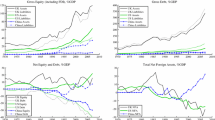Abstract
The literature on international portfolio diversification explored the benefits of international diversification and the pricing of securities in an international context largely from the perspective of an integrated world capital market. Imperfections in the international markets were acknowledged as exogenous variables added to the basically integrated market, and their effects on security prices, consequences of diversification,etc, were then measured. All studies are related, explicitly or implicitly to two extreme situations. One extreme situation is complete segmentation, the other is perfect market integration. This paper begins with a literature review to illustrate the inadequacy of either of the extreme situations described above. A case of partial integration where the barriers are an endogenous part of the model is then presented. Indirect and circumstantial evidence that the international financial markets are partially integrated by design, and not as a result of market failures, is then presented as a preliminary validation of the partial integration model.
Similar content being viewed by others
References
Adler, M and Dumas, B, (1975), Optional international acquisitions,Journal of Finance 30, March, 1–20.
Agmon, T, (1972), The relations among equity markets in the United States, United Kingdom, Germany and Japan,Journal of Finance 27, September, 839–56.
Agmon, T, (1973), Country risk: the significance of the country factor for share-price movements in the United Kingdom, Germany and Japan,The Journal of Business 46, No 1, 24–32.
Agmon, T and Hirsch, S, (1979), Multinational corporations and the developing economics: potential gains in a world of imperfect markets and uncertainty,The Oxford Bulletin of Economics and Statistics 41, No 4, 333–344.
Agmon, T and Lessard, D, (1977), Investor recognition of corporate international diversification,Journal of Finance 32, September, 1049–56.
Black, F, (1974), International capital market equilibrium with investment barriers,Journal of Financial Economics 1, December, 337–52.
Caves, R, (1971), Industrial corporations: the industrial economics of foreign investment,Economica 38.
Cohn, R and Pringle, J, (1972), Imperfections in the international financial markets: implications for risk premia and the cost of capital to firms,The Journal of Finance 27, No 1.
Errunza, U and Senbet, L, (1981), The effects of international operations on the market value of the firm: theory and evidence,Journal of Finance 36, May, 401–17.
Eun, C and Resnick, B, (1984), Estimating the correlation structure of international share prices,Journal of Finance 39, December, 1311–24.
Grauer, F, Litzenberger, R and Stehle, R, (1976), Sharing rules and equilibrium in an international capital market under uncertainty,Journal of Financial Economics 3, June, 233–56.
Grubel, H, (1968), Internationally diversified portfolios: welfare gains and capital flows,American Economic Review 58, December, 1299–1314.
Hughes, J S, Logue, D E and Sweeney, R J, (1975), Corporate international diversification and market assigned measures of risk and diversification,Journal of Financial and Quantitative Analysis, November 627–637.
Hymer, S, (1960),The International Operations of National Firms, A Study of Direct Investment, Diss, MIT.
Jacquillat, B and Solnik, B, (1978), Multinationals are poor tools for diversification,The Journal of Portfolio Management 4, No 2, 8–12.
Khoury, S J, (1980),Dynamics of International Banking, Praeger.
Kindelberger, C P, (1969),American Business Abroad, Yale University Press.
Lessard, D, (1973), International portfolio diversification: a multivariate analysis for a group of Latin American countries,Journal of Finance 28, June, 619–633.
Lessard, D, (1974), World, national and industry factors in equity returns,Journal of Finance 29, May, 379–91.
Lessard, D, (1976), World, country and industry relationships in equity returns: implications for risk reduction through international diversification,Financial Analysts Journal, January/February, 2–8.
Levy, H and Sarnat, M, (1970), International diversification of investment portfolios,American Economic Review 60, September, 668–75.
Logue, D R, Salant, M, and Sweeney, R J, (1976), International integration of financial markets: survey, synthesis and results, in Stern, Makin and Logue, eds:Eurocurrencies and the International Monetary System, American Enterprise Institute, Washington.
Markowitz, H, (1959),Portfolio Selection: Efficient Diversification of Investments, John Wiley and Sons, New York.
McDonald, J, (1973), French mutual fund performance: evaluation of diversified portfolios,Journal of Finance 28, December, 1161–80.
Roll, R and Ross, S A, (1984), The arbitrage pricing theory approach to strategic portfolio planning,Financial Analysts Journal, May/June, 14–26.
Solnik, B, (1974), An equilibrium model of the international capital market,Journal of Economic Theory 8, August, 500–24.
Author information
Authors and Affiliations
Additional information
The authors are thankful for the very valuable comments of Professor Peter Kaus of UCR.
Rights and permissions
About this article
Cite this article
Agmon, T., Khoury, S. Political economy of international diversification: The case for partial integration. Asia Pacific J Manage 8, 237–247 (1991). https://doi.org/10.1007/BF01731943
Issue Date:
DOI: https://doi.org/10.1007/BF01731943




